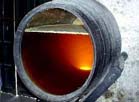A wine is defined as “oxidized” when it has been exposed to oxygen for a prolonged period, causing significant changes in its color, aroma, and flavor. Indeed, oxygen has long been considered “wine’s enemy.” Pasteur was likely the first to recognize oxygen as an essential factor in the evolution of a red wine. Oxidation is a chemical process that occurs when wine comes into contact with oxygen, and can be either intentional or unintentional. Oxidative wines are the result of ancient techniques that exploit contact with oxygen to create unique and intense flavors.
Oxidative wines are a category of wines characterized by prolonged contact with oxygen during the production and aging process. Unlike most wines, which seek to limit exposure to oxygen to preserve freshness and primary aromas, in oxidative wines, air becomes a fundamental component for the development of complex and unique aromas.
Among the best-known oxidative wines are Vin Jaune del Jura, Marsala, Sherry, and some Vernaccia di Oristano.

The production technique also called intentional oxygenation(Oxidative wines): the role of oxygen
The production of oxidative wines requires meticulous management of oxidation. This process can be achieved through specific techniques such as:
- Refining under veil: As in the case of Fino Sherry, where a layer of yeast (flor”) partially protects the wine, allowing for slow oxidation and the formation of unique aromas.
- Refining without oxygen protection: as in the Vin Jaune, aged in empty barrels for several years, during which complex aromas of nuts, spices and dried fruit develop.
The material of the barrels, usually wood, and the aging time are fundamental in defining the character of the wine.
In Italy they are called “oxidative”, in Spain “rancio” and “vin de voile” in France: these types of wines in contact with oxygen become a real niche in the wine sector.
Unintentional oxygen production in wine
- Unintentional: This is a defect and can ruin the wine. Accidental oxidation can result from poor storage practices, such as improper closure or prolonged opening of the bottle.
Sensory Profile: Oxidative wines offer a rich and complex aromatic bouquet. Among the most common sensory notes are:
- Walnuts and almonds: resulting from the reaction between oxygen and phenolic compounds..
- Spices and roasting: such as cinnamon, nutmeg and vanilla, often influenced by the use of barrels.
- Dried and candied fruit: including apricots, dates and figs.
These wines have a strong structure and a pleasant persistence, making them perfect for pairing with rich, flavorful dishes, such as aged cheeses, foie gras, and almond-based desserts.
Why choose an oxidative wine?
Oxidative wines are not only a refined alternative, but also a piece of winemaking history. The traditional techniques used to produce them reflect a unique cultural heritage, often tied to specific terroirs. These wines are appreciated for their ability to evolve over time, offering an ever-changing tasting experience. In a world increasingly geared toward standardization, oxidative wines offer a window into authenticity and diversity.
